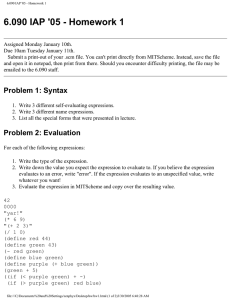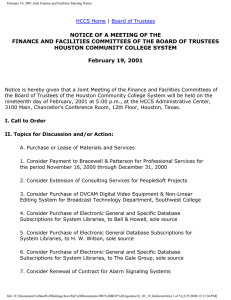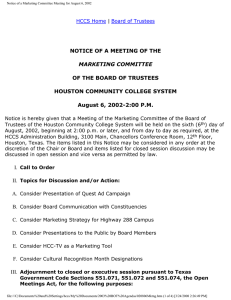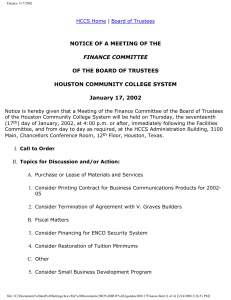The Nature of Complex Subatomic Entities
advertisement
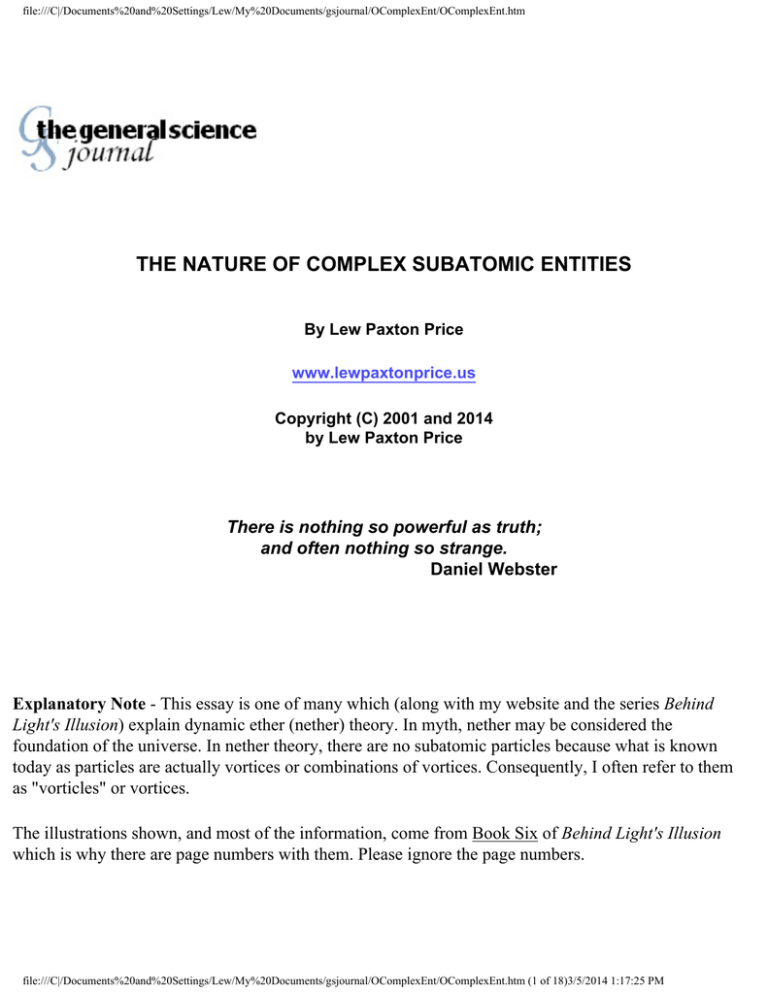
file:///C|/Documents%20and%20Settings/Lew/My%20Documents/gsjournal/OComplexEnt/OComplexEnt.htm THE NATURE OF COMPLEX SUBATOMIC ENTITIES By Lew Paxton Price www.lewpaxtonprice.us Copyright (C) 2001 and 2014 by Lew Paxton Price There is nothing so powerful as truth; and often nothing so strange. Daniel Webster Explanatory Note - This essay is one of many which (along with my website and the series Behind Light's Illusion) explain dynamic ether (nether) theory. In myth, nether may be considered the foundation of the universe. In nether theory, there are no subatomic particles because what is known today as particles are actually vortices or combinations of vortices. Consequently, I often refer to them as "vorticles" or vortices. The illustrations shown, and most of the information, come from Book Six of Behind Light's Illusion which is why there are page numbers with them. Please ignore the page numbers. file:///C|/Documents%20and%20Settings/Lew/My%20Documents/gsjournal/OComplexEnt/OComplexEnt.htm (1 of 18)3/5/2014 1:17:25 PM file:///C|/Documents%20and%20Settings/Lew/My%20Documents/gsjournal/OComplexEnt/OComplexEnt.htm Mass - "Mass with a capital "M" is the name for a quantity of nether (dynamic ether). What we call "mass" is the amount of "Mass" flowing out of our three-dimensional space in a particular length of time. "Mass" flow is the cause of "mass", and mass is the constituent of matter. Therefore, matter is the ultimate result of nether flow in one direction of the fourth dimension, and antimatter is the ultimate result of nether flow in the opposite direction of the fourth dimension. M = m/t Charge - Since vorticles in the same vicinity have almost the same direction of relative nether flow passing them, they tend to orient themselves so that their mouths point in the same general direction. This allows the phenomenon of charge to exist. The nether flow into any two vorticles (vortices) can be either to some extent in the same direction of rotation or to some extent in opposite directions of rotation. Those of like charge rotate in essentially the same direction and repel one another because each is inclined to want as much nether for as little energy as possible - and that is best accomplished with them at a distance from one another. Those of unlike charge rotate in essentially opposite directions and want the same volume of nether, which tends to draw them closer to one another. Therefore, the phenomenon we call "charge" is the result of the actual direction of nether flow into two vorticles. Micro-gravity - The radial vector of nether flow in a vortex pulls entities toward the vortex. This is a very weak force compared to charge and operates in more of a planar fashion in that its effect is largely confined to a disc-like shape as it moves outward. Gravity - Gravity is caused by many grouped vorticles generating their planar micro-gravity. The orientations of the grouped vortices vary, and they are all in the same large neighborhood, so that their micro-gravities average as one large force moving outward as a sphere rather than a disc. The result is a nether flow from infinity toward the center of the grouped vorticles. Thus, at any radius from the center of the group is a mathematical sphere whose center coincides with the center of the group. Each mathematical sphere acts like the cross-section of a funnel, and each crosssection has less area as the inflowing nether approaches the center of the group. file:///C|/Documents%20and%20Settings/Lew/My%20Documents/gsjournal/OComplexEnt/OComplexEnt.htm (2 of 18)3/5/2014 1:17:25 PM file:///C|/Documents%20and%20Settings/Lew/My%20Documents/gsjournal/OComplexEnt/OComplexEnt.htm The relative proximity of the vorticles in the group creates considerably more inward nether flow per unit area than would be the case with a single vorticle. This causes nether flowing into the group to compress in the directions which are tangent to any of the mathematical spherical surfaces while expanding in the inward radial direction. The resulting "squeezing" creates greater nether density and greater nether acceleration as the nether approaches the center of the group. It is the nether acceleration in this funnel that we call "gravity", and which varies according to the inverse square law. Spin - Spin is also called "angular momentum", but even the particle physicists know that it is not actual angular momentum. Actual spin is the result of the tangential vector of nether movement. In a simple vorticle, such as the electron, or in the vortex of a complex vorticle like the proton, this vector is at right angles to the micro-gravity vector. The actual movement which causes charge is the resultant of the micro-gravity vector and the spin vector. Spin causes an entity to behave as if it were a gyroscope. The Planck unit of action is Planck's constant divided by pi. According to particle physicists, the class of particles called fermions have a spin of one-half of the Planck unit of action. If the sum of the electrons, protons, and neutrons that constitute a particle of matter is an odd number, that particle is a fermion and it has a spin of one-half of the Planck unit of action. If that sum is an even number, the particle is a gauge bosun with a spin of one Planck unit of action. Fermions supposedly interact with gauge bosuns. Usually, spin is given as a number without the necessity of adding "Planck unit of action". (If you ever meet me, don't expect me to remember these particle physics things. I write books and essays so that I can read them later when I have questions. Nether theory is simple and correct - and these things from particle physicists are complicated and usually incorrect. I don't recommend that you attempt to memorize them because it would be a waste of effort. Bad enough that I had to temporarily learn them before I could translate them into something sensible.) Simple Stable Vorticles - There are only two simple, stable vorticles: the electron and the positron. These are vortices made of nether which remove nether from our space, and are energized by the difference between the vacuum at their centers the pressure of the nether within our space. These vorticles are called "leptons" and are not affected by the nuclear strong force. file:///C|/Documents%20and%20Settings/Lew/My%20Documents/gsjournal/OComplexEnt/OComplexEnt.htm (3 of 18)3/5/2014 1:17:25 PM file:///C|/Documents%20and%20Settings/Lew/My%20Documents/gsjournal/OComplexEnt/OComplexEnt.htm The Tunnel Vortex - This is a vortex which exists in a tube-like volume of space. At one end is its mouth where nether enters. The other end is where nether exits. The tunnel vortex can exist because (1) the centrifugal force of its nether rotation is opposed equally by the nether pressure surrounding it, and (2) the frictionless nature of nether allows the rotation to continue. The tunnel vortex can exist only as a component of complex vorticles. The tunnel vortex is part of a quarkon or antiquarkon. It is rather Massive in the form of what some call a glueball (assuming there are glueballs). However, the nether theory glueball, which is a single tunnel vortex with its mouth on its tail, has no micro-gravity of its own, and no charge. It has spin in the sense of a spinning tube turned into a doughnut, but this kind of spin cancels itself out. [The theoretical glueball of currently accepted physics is a three-color monstrosity of curled gluons.] The tunnel vortex (misnamed "gluon") cannot exist alone for long, but for the time it exists, at its mouth there is charge, spin, and micro-gravity - because its mouth is like a common vortex. As part of the quarkon, it furnishes this entity's charge, spin, and micro-gravity. Quarks and Quarkons - For a tunnel vortex to be created, it must have a hole at its exit end into the fourth dimension. This hole is either a quark or an antiquark. "Quarkon" is the name given to a vorticle formed as a tunnel vortex and a quark or an antiquark. Neither is stable when alone, but may be stable for a time when joined. When we take a bath (yes, most people take showers now), we see that when the water has a depth of between eight inches and a foot, the column that is the whirlpool that drains the tub writhes as if it were alive. The whirling column is hollow only at its very center, and its average diameter near the top is slightly more than its average diameter near the bottom. If someone sweeps the whirlpool aside from the drain, it continues to swirl momentarily and then reforms over the drain hole. This longer whirlpool might be similar to what the center of a massive vorticle would look like if it were visible. That portion of the whirlpool between the top and a point directly above the drain is like half of a gluon. The part at the drain is like a quark. In other words, the quark and half of the gluon are parts of a single entity. However, the water in the tub is composed of molecules, allowing the presence of friction. This allows some water to enter the whirlpool from all along its length. Nether is frictionless, so it is possible for a nether whirlpool to exist with nether entering only at the top. The "sides" merely spiral downward, furnishing enough centrifugal force to offset the nether pressure outside. Unlike the electron center, which is largely hollow, the centers of more massive vorticles such as quarks would be almost filled with nether. Their nether flow would also have a resultant inward acceleration file:///C|/Documents%20and%20Settings/Lew/My%20Documents/gsjournal/OComplexEnt/OComplexEnt.htm (4 of 18)3/5/2014 1:17:25 PM file:///C|/Documents%20and%20Settings/Lew/My%20Documents/gsjournal/OComplexEnt/OComplexEnt.htm equal to "c" multiplied by the square root of two. However, at any particular point, no two of their three nether acceleration vectors would necessarily be equal. The vector directly into the hole would dominate considerably, and the radial and tangential vectors would be unequal and vary consideraby according to their distance from the exact center of the whirlpool and their distance from the hole. In nether theory, the quark is caused by a hole in one direction of the fourth dimension. The antiquark is caused by a hole into the opposite direction of the fourth dimension. This is because the pressure involved during their mutual creation develops a balanced reaction with the inertia in one direction opposing the inertia in the opposite direction. The gluon is the column of spiralling nether between the quark and the antiquark. Half of the gluon is formed of nether moving toward the hole which is causing the quark. The other half of the gluon is formed of nether moving toward the hole which is causing the antiquark. The complete entity is either a quarkon (quark with its half of the gluon) or an antiquarkon (antiquark with its half of the gluon). The quark and the antiquark may be considered holes like those of the electron and positron, but,with more Mass flowing into them, they are hungrier. To conserve energy, they tend to move in the direction their mouths are pointing. Since they are formed with their mouths pointing toward one another, and since the so-called gluon keeps them oriented in that manner, they tend to move toward one another with constant force, regardless of their distance apart (within reason). The quarkon,as I define it, is composed of the quark and half of the gluon which is composed of spiralling nether moving toward the quark. The antiquarkon is composed of the antiquark and the half of the gluon's spiralling nether that is moving toward the antiquark. Neither the quarkon nor the antiquarkon are stable when alone. The nether flow into each must be through its long tunnel vortex (half-gluon) for its mass flow into the hole to be large enough to maintain its existence. Without the long neck of the whirlpool that is the tunnel vortex, the nether flow into the hole would be largely hollow and tangential. For a more massive vorticle to exist, the average tangential flow vector at the hole itself must be small as compared to the average downward vector (the one straight into the hole). This is based upon the equation for centrifugal force: Fc = mv2/r . Note that a mass increase and a small radius increases the centrifugal force. When the quarkon is part of a pion, the long neck allows the necessary distance for this condition to manifest. The neck is reduced in a baryon (a three-quark composite particle in particle theory and a threequarkon composite vorticle in nether theory). The hole itself, in both cases, is essentially filled - contrary to the hollow condition of the hole of an electron or positron. As already stated, quarks do not exist for very long when alone. Lone quarks have been created by the annihilation of electron-positron pairs. The energy which results from that annihilation is in the form of file:///C|/Documents%20and%20Settings/Lew/My%20Documents/gsjournal/OComplexEnt/OComplexEnt.htm (5 of 18)3/5/2014 1:17:25 PM file:///C|/Documents%20and%20Settings/Lew/My%20Documents/gsjournal/OComplexEnt/OComplexEnt.htm photons which then create quarks and gluons. The quarks and gluons decay in much less time than the blink of an eye. Remember that an electron center is probably "hollow" in the same sense that a whirlpool is hollow such as the one that you would see when water drains from a bathtub with a good drain. Much of the Mass flow into an electron center is at the perimeter of the hole and enters at an angle that creates sufficient centrifigal force to keep the hole open. So the electron center is relatively large and hollow. If more of the Mass flow could be entering at right angles from the plane of the hole, the hole could be filled up with Mass entering it and the mass (remember m = M/t) of the vorticle would increase. In such a vorticle, the tangential vector for the Mass flow would decrease which would reduce the size of the hole until its lessened radius caused the new centrifugal force to equal the nether pressure (centrifugal force = Mv2/r). Such a vorticle could be smaller than the electron and still more massive. The tunnel vortex causes the Mass flow to enter almost straight into the hole, but how was the tunnel vortex created and maintained? The quarkon was created with the tunnel vortex, the nether itself is frictionless, and the nether pressure around the vortex prevents the centrifugal force within it from expanding outward. Pions - A meson is a quark and an antiquark combined. The pi-meson, or "pion" for short, is a transitory entity composed of a quarkon and an antiquarkon whose "mouths" are "kissing". The suction of these mouths is a form of the strong force which is measured as a loss of mass (Mass flow) equated to energy terms via the equation E = mc2. When certain manmade high-energy collisions occur, some composite entities called neutral pions are observed which are currently accepted as an up quark and an up antiquark held together by a gluon, or a down quark and a down antiquark held to together by a gluon. The gluon appears to be a tube in which there is a flow believed to be from the quark to the antiquark (see Glueballs in by Frank E. Close and Philip R. Page in the November 1998 issue of Scientific American). In nether theory, the quark and the antiquark are holes into the fourth dimension. The vortex which forms at each is half of the so-called gluon between the two. The "gluon" is actually two tunnel vortices formed as a result of their "mouths" which are "kissing" due to the suction between them. A quark or antiquark is much more massive than an electron. And unlike the electron, neither is stable in a free state. The pion is not stable either and decays quickly. To form and maintain a hole into the fourth dimension, there must be centrifugal force to overcome the local nether pressure and a balance between file:///C|/Documents%20and%20Settings/Lew/My%20Documents/gsjournal/OComplexEnt/OComplexEnt.htm (6 of 18)3/5/2014 1:17:25 PM file:///C|/Documents%20and%20Settings/Lew/My%20Documents/gsjournal/OComplexEnt/OComplexEnt.htm the centrifugal force and the nether pressure. A more massive vortex, to maintain the correct balance even for a short time, must (1) be filled in the middle (as opposed to the hollow electron center), and (2) have most of its nether movement in the form of a vector at right angles to the plane of the hole. [Because the hole is taking the nether into the fourth dimension which is at right angles to all three of our dimensions of space, the nether entering the hole at right angles to its plane with still turn at a right angle when entering the fourth dimension and will still be affected by centrifugal force.] The tube (tunnel) which is called the "gluon" is held in together by the nether pressure which surrounds it. Otherwise, the centrifugal force of the vortex within it would cause it to spread outward. Just as two hoses from two household vacuum cleaners would hold themselved together when placed "mouth-to-mouth", the two halves of the "gluon" maintain the short-lived integrity of the "gluon" by "kissing". "Binding energy" is a term used to show the reduction of mass (M/t) which results when nether inflow into an entity is blocked in some manner. For instance, the air entering the two vacuum cleaner hoses is partly blocked when they are facing one another mouth-to-mouth. This means less mass of air entering the hoses. This reduction in air mass could be equated to the energy needed to hold the two hoses together and called "binding energy". In nuclear physics, binding energy is found by subtracting the combined masses of two joined subatomic particles from the sum of their masses when they are separate. The mass difference is converted to energy by the mass-energy equation E = mc2. The result is "binding energy". The quark plus its half of the gluon is what I have termed a "quarkon". It has a vortex direction that is the opposite of that of its mirror-image antiquarkon. However, when the two vortices "kiss", they are facing one another from opposing directions and their vortices are "in synch". This means that the vortices will be attempting to acquire the same volume of nether and there is a corresponding loss of mass (Mass flow) which is called "binding energy" and is a form of the nuclear strong force. There is a positive pion which is formed by an up quark and a down antiquark, and a negative pion which is formed by a down quark and an up antiquark. Both of these pions are composed of vortices with rotations which are opposite to one another when they are facing. This means that the vortices are still "sucking", in a slightly different variation of the strong force, and still use "binding energy" - but they do not compete for the same volume of nether. The frictionless nether at their mouths simply slides over itself. More Mass is taken into the fourth dimension, so it appears that less binding energy is used when two vortices do not compete for the same volume of nether. Therefore, positive and negative pions have more mass (greater nether inflow) than neutral pions which are made of mirrored quarkons. file:///C|/Documents%20and%20Settings/Lew/My%20Documents/gsjournal/OComplexEnt/OComplexEnt.htm (7 of 18)3/5/2014 1:17:25 PM file:///C|/Documents%20and%20Settings/Lew/My%20Documents/gsjournal/OComplexEnt/OComplexEnt.htm file:///C|/Documents%20and%20Settings/Lew/My%20Documents/gsjournal/OComplexEnt/OComplexEnt.htm (8 of 18)3/5/2014 1:17:25 PM file:///C|/Documents%20and%20Settings/Lew/My%20Documents/gsjournal/OComplexEnt/OComplexEnt.htm According to currently accepted theory, the gluon pulls at the quark and the antiquark of the pion to hold them together. This pull is constant regardless of the length of the gluon. The fact that the pull is constant is something that accepted theory has not explained. It would seem that the pull would be stronger as the gluon stretches. In nether theory, there is no gluon. The gluon is merely two extended vortices. The quark and the antiquark are holes into the fourth dimension. These holes attempt to conserve energy by moving with a constant force in the direction that their mouths are pointed. This is a variation of the way a vorticle such as the electron does the same thing. Of course, there would be a constant force between the two holes of a pion and the length of the tunnel vortices would make no difference. file:///C|/Documents%20and%20Settings/Lew/My%20Documents/gsjournal/OComplexEnt/OComplexEnt.htm (9 of 18)3/5/2014 1:17:25 PM file:///C|/Documents%20and%20Settings/Lew/My%20Documents/gsjournal/OComplexEnt/OComplexEnt.htm file:///C|/Documents%20and%20Settings/Lew/My%20Documents/gsjournal/OComplexEnt/OComplexEnt.htm (10 of 18)3/5/2014 1:17:25 PM file:///C|/Documents%20and%20Settings/Lew/My%20Documents/gsjournal/OComplexEnt/OComplexEnt.htm It is ironic that for a quarkon to exist as part of a pion, the long tunnel vortex (half gluon) must be maintained. Without a means of maintaining the tunnel vortex, the quarkon would cease to exist. Yet, when a pion is on its own, the quark and the antiquark tend to move toward one another, eliminating the tunnel vortices. The Proton - This is a stable complex vorticle which has a positive charge. It is formed from three quarkons who are aligned at ninety degrees to one another with their mouths at a common point. In the proton, the three quarkon mouths are positioned so as to create a volume for appreciably greater nether flow into them, and this greatly increases the mass of the quarkons. The up quarkon, of which there are two, have a charge of +1, while the down quarkon of which there is one, has a charge of -1. However, their placement causes the charge of each up quarkon to be reduced to only +2/3, and the charge of the down quarkon to be reduced to -1/3. The quarkons are aligned almost as if they were the lines formed from the intersections of three planes of a tetrahedron. Where the lines meet is where the mouths of the quarkons meet. If the tetrahedron is pointed with the lines meeting at the top, above the tetrahedron a vortex is formed which has a charge of +1 and a spin of +1/2. The quarkons of a proton are very short as compared to those of a pion because their quarks (holes) have moved toward their mouths. If we could see the concentrated portion of the Mass that forms the proton, we would see that the common vortex formed by the quarkons constitutes most of the Mass of the entity. The proton is classed as a "hadron", a complex vorticle that "feels" the strong force. It is also a "baryon". A baryon is a three-quark composite. The proton and neutron are baryons which are also called nucleons (entities that are found in the nucleus of an atom). The proton is a stable baryon and the neutron is stable only when it is part of the nucleus of an atom. Quantum Chromodynamics (QCD) - The three quarkons of the proton must meet at approximately ninety degrees to one another for the proton to remain stable. Those who subscribe to quantum chromodynamics (QCD) have given each direction something called a "color charge". Thus, according to QCD, the quarks which form the proton are of three "colors" which are given either as red, yellow, file:///C|/Documents%20and%20Settings/Lew/My%20Documents/gsjournal/OComplexEnt/OComplexEnt.htm (11 of 18)3/5/2014 1:17:25 PM file:///C|/Documents%20and%20Settings/Lew/My%20Documents/gsjournal/OComplexEnt/OComplexEnt.htm and blue, or red, green, and blue (according to who is writing about them). The point is that the three colors of quarks make white which is the nature of a baryon. A blue quark cannot join with any other two to form a baryon unless the other two quarks are red and yellow. A yellow quark cannot join with any other two to form a baryon unless the other two quarks are blue and red. And a red quark cannot join with any other two to form a baryon unless the other two quarks are blue and yellow. The quarkons of a pion must be aligned in two opposing directions for them to form the pion. Thus, for a pion to be formed, a blue quarkon must meet with an antiblue quarkon. A yellow quarkon must meet with an antiyellow quarkon. Or a red quarkon must meet with an antired quarkon. Whereas Quantum Electrodynamics (QED) is a currently accepted theory on electromagnetism, QCD is a currently accepted theory to explain things called baryons and mesons. The previously mentioned pions are mesons (pi mesons). It is QCD which uses the three colors of quarks, antiquarks, and gluons. The three colors of quarks have been explained previously, but there is more to QCD which can be explained at this point. First of all, in QCD, the tunnel vortices of the quarkons have been separated to form what is called gluons, leaving the quarks (holes) alone and without vortices. There is a theorized thing called a glueball, analogous in nether theory to a separated tunnel vortex curled around so that its mouth is against its tail. If the tunnel vortex (half-gluon) can be made to do this, the resulting object is possible. It would have no charge, no mass in the sense that m = M/t (where M/t is Mass flow into the fourth dimension), but would have a lot of Mass (nether material) circulating within its own volume. Its angular momentum would be such that the effect of one "side" of it would cancel the effect of the other side, leaving it without any apparent angular momentum. The glueball would only exist temporarily. The pion is an example of aligned color and anticolor charges. In QCD, the pion must be made of a red quark with a red antiquark, a yellow quark with a yellow antiquark, or a blue quark with a blue antiquark. Mixed marriages are not allowed. It is obvious in nether theory that quarks and antiquarks must be aligned properly to have the effects that they do, so it is logical that color be the means of distinguishing alignment of quarkons. However, QCD has a number of problems due to the fact that it is diffult to see something that is merely a mathematical construct. If one wishes to better understand the currently accepted theory of QCD, one should read the explanations in current-day physics books or science magazines. According to nether theory (which I believe is a more accurate version of reality), QCD is unnecessary. QCD has been supplanted by the directions of the tunnel vortices (given above). In time, QCD will go into the same void as phlogiston (a substance that was once supposed to make things flammable). QCD is being mentioned here merely to show the readers what QCD is. file:///C|/Documents%20and%20Settings/Lew/My%20Documents/gsjournal/OComplexEnt/OComplexEnt.htm (12 of 18)3/5/2014 1:17:25 PM file:///C|/Documents%20and%20Settings/Lew/My%20Documents/gsjournal/OComplexEnt/OComplexEnt.htm Proton Composition without QCD - I believe that each color of quark is actually a direction with respect to two other directions. The baryon is formed from three quarkons rather than quarks with gluons. The tunnel vortices of the quarkons must have their mouths joined at the baryon center, forming a figure like a tetrahedron with one point as the location of the three mouths and from which the tunnel vortices extend with each at approximately ninety degrees to the other two. Such a figure would have the effect of sealing off nether inflow from all points except the area left open where the mouths converge and which is outside the tetrahedron. This configuration allows maximum nether flow into the three mouths. In the proton, there are two up quarkons and one down quarkon. Each individual quarkon can be of any direction regardless of whether it is an up or a down quarkon, as long as there is one quarkon of each direction in the composite (each direction is at right angles to the other two). When two of the three tunnel-vortex mouths join, if the directions of their nether flows oppose one another, they cannot attempt to pull in the same volume of nether. If they do not oppose, they intermingle as if they were two circles of the same size in which the circumference of each passes through the center of the other. The points where the circumferences cross one another have exactly onethird of the total circumference of each between them. This causes one-third of the nether flow which acts as charge to be eliminated from each mouth. file:///C|/Documents%20and%20Settings/Lew/My%20Documents/gsjournal/OComplexEnt/OComplexEnt.htm (13 of 18)3/5/2014 1:17:25 PM file:///C|/Documents%20and%20Settings/Lew/My%20Documents/gsjournal/OComplexEnt/OComplexEnt.htm file:///C|/Documents%20and%20Settings/Lew/My%20Documents/gsjournal/OComplexEnt/OComplexEnt.htm (14 of 18)3/5/2014 1:17:25 PM file:///C|/Documents%20and%20Settings/Lew/My%20Documents/gsjournal/OComplexEnt/OComplexEnt.htm The accepted theory at this time is that the up quark has a charge of "2/3" and the down quark has a charge of "-1/3". According to nether theory, the up quarkon has a charge of "1" and the down quarkon has a charge of "-1". However, in the proton, the mouths of each up quarkon touch one another and also touch the mouth of the down quarkon. Where the two up quarkon mouths touch, there is no reduction of charge (opposite nether flow). Where the mouths of each touch the down quarkon mouth, there is a reduction of 1/3 of their charge, leaving them each with a charge of "2/3". The down quarkon charge is similarly reduced as it touches the two up quarkon mouths, so that "2/3" of its charge is gone, leaving it with a charge of only "-1/3". The result is the same as if there were two up quarks with a charge of "2/3" each and a down quark with a charge of "-1/3". 2/3 + 2/3 - 1/3 = 1, which is the charge of the proton. Where the three mouths touch, a major vortex is formed which is what accepted theory believes to be "glue". This vortex forms the bulk of the proton Mass. Because the quarkon mouths form in a modified triangular manner as seen from the open portion, there is a large area into which nether can flow. This allows far more flow than is the case with a pion where the quarkon mouths are pressed directly against one another. Therefore, the proton has a far greater mass (which is Mass flow) than the sum of the masses of three quarkons as seen in a pion. The large resulting Mass flow of the large vortex of the proton is what gives it its charge of "+1" and its spin of "+1/2". In essence, the proton is an entity of three quarkons with their mouths converging so that their tunnel vortices extend at ninety degrees to one another with a large vortex formed where the nether enters the converging quarkon mouths. Quarkons cannot exist for long in a pion or in a free state because (1) they must have the correct "impedance" of nether flow (that which is in a proton) to maintain their tunnel vortices, and (2) they must not be allowed to mutually annihilate as can happen with those in a pion. The tetrahedron configuration of the quarkons in the proton is the only way for the quarkons to obtain the maximum amount of nether in any given length of time. It makes no difference which quarkon is in any particular position of the tetrahedron because the resulting large vortex will be the same in any case. This can be seen if you draw a picture of the quarkons and their tunnel vortices, and then mentally make them exchange positions. The Neutron - In nether theory as seen at this time, the neutron is a proton joined with an electron. Neutrons cannot exist alone, but use electrons to form bonds with protons in atomic nuclei. file:///C|/Documents%20and%20Settings/Lew/My%20Documents/gsjournal/OComplexEnt/OComplexEnt.htm (15 of 18)3/5/2014 1:17:25 PM file:///C|/Documents%20and%20Settings/Lew/My%20Documents/gsjournal/OComplexEnt/OComplexEnt.htm The Delta+ - There is a transitory entity called the delta+ which is like a proton but with a down quarkon "reversed" (moved so that its mouth is essentially near the quarks (holes) of the two up quarkons. This entity has a spin of 3/2 and 30% more mass than a proton. This is logical because the nether inflow to all the quarkons is increased and they are aligned so that all three spin together. The Spin One Hydrogen Atom - When the "orbiting" electron of a hydrogen atom is forced (with added energy) to reverse its polarity, so that its spin is oriented in the same direction as that of the proton nucleus, the mass of the hydrogen atom is increased. The spin of the atom is normally zero (+1/2 -1/2 = 0), but with the electron polarity reversed, the spin of the atom is one (+1/2 +1/2 = 1). This is correct and logical according to nether theory, because the vortices of the proton and electron are rotating in the same direction. Coriolis Force - Coriolis force, as we look upon it today, is caused by the inertia of a mass moving upon a surface which is rotating, or moving away or toward a surface which is rotating. It is the effect of inertia preventing a mass from accelerating to match the apparent change in linear velocity caused by rotational motion. Meteorologists (weathermen) use it all the time because it is one of the chief reasons that our weather behaves as it does. An air mass moving within the northern hemisphere curves to the right. An air mass moving within the southern hemisphere curves to the left. The result is circular highs and lows rotating with winds sometimes as great as those found in a tornado. There is a law in at least our part of the universe in which simple stable vortices (the electron) must be negatively charged (the vortex started in a particular direction of rotation) and in which protons must be positively charged (the vortex started in the opposite direction of rotation). This law is caused by a form of coriolis force. Bias: There is an "up/down" bias due to the fourth dimension which established matter in one file:///C|/Documents%20and%20Settings/Lew/My%20Documents/gsjournal/OComplexEnt/OComplexEnt.htm (16 of 18)3/5/2014 1:17:25 PM file:///C|/Documents%20and%20Settings/Lew/My%20Documents/gsjournal/OComplexEnt/OComplexEnt.htm direction of flow and antimatter in the opposite direction of flow. In meteorology, this is analogous to the up/down bias relative to the surface of earth. Inertia: There is inertia of nether Mass which, in meteorology, is analogous to the mass of the air in our atmosphere. Pressure: There is a nether pressure variation which causes motion and which, in meteorology, is analogous to the variation of pressure between highs and lows in our atmosphere. The final ingredient: It is quite likely that when the universe was formed as a point, the point that was the universe was spinning to some extent. This would create coriolis force just as a phonograph record would do for an insect landing on it when it was rotating. And there is a form of "jerk" which is a change in acceleration according to position in the universe. In meteorology, this is analogous to a change in velocity according to the position on the surface of the earth. Although I have not discovered which direction of rotation is which, we may use the accepted convention in electromagnetism to explain this. Looking upon the right-hand side of our universe from the "top", we would see a moving mass curve to the right. This is analogous to the curving path to the right of a mass of moving air in the northern hemisphere of our planet. Electron/positron formation from the collision of two gamma rays is an event of high pressure and the resulting motion is to the right, making the electron vortex turn in a clockwise direction. The events which cause quarkon/antiquarkon creations are high pressure, and with more of a direct punch into the fourth dimension, so that both positive and negative vortices are formed (quarkons which have both clockwise and counterclockwise vortices). The way the quarkons form to make a proton causes the creation of a large "low pressure area" which must have counterclockwise rotation. So, a negative proton cannot exist as a form of matter and a positive proton cannot exist as a form of antimatter. Therefore, we have a universe (at least where we are within it) of negatively charged electrons and positively charged protons, and of positively charged anti-electrons (positrons) and negatively charged antiprotons. file:///C|/Documents%20and%20Settings/Lew/My%20Documents/gsjournal/OComplexEnt/OComplexEnt.htm (17 of 18)3/5/2014 1:17:25 PM file:///C|/Documents%20and%20Settings/Lew/My%20Documents/gsjournal/OComplexEnt/OComplexEnt.htm A Universe of Puzzles - It seems that the Creator, the Force which started the motion which began the building of the universe as we know it, was deliberately giving us a puzzle - a toy like a computer game. Whatever the motive (if there is one), the result is a veil over the reality which is partly caused by our limited senses, and partly caused by our perspective within the cosmic fluid. We are often frustrated by our lack of knowledge and our apparent inability to rule our own destinies. The puzzle in which we live is often more than we can grasp. Even if we are certain that the joys and sorrows of our lives are but temporary illusions, we are caught up in the game. We are forced to take part in the dance of life. But would we prefer to be bored? The game serves as a most efficient and strict teacher for those who are willing to learn. And those who are not willing to learn now will be willing later when they are too worn down to resist. This is a game of survival and the best way to survive is to learn the rules. Is it wise to discover what lies behind light's illusion? Could it be that when we discover it all, the universe will disappear to be replaced with another puzzle for us to play with for a time? Will time cease to exist when we have understood its true nature? An illusion can be fun. Should we spoil its fun by looking behind it? But even if we were fearful of the consequences, would we stop looking for the answers? We are creatures filled with curiosity. We will venture onward regardless until we learn the truth. In saffron-colored mantle, from the sides of ocean rose the morning to bring light to gods and men. Homer file:///C|/Documents%20and%20Settings/Lew/My%20Documents/gsjournal/OComplexEnt/OComplexEnt.htm (18 of 18)3/5/2014 1:17:25 PM


